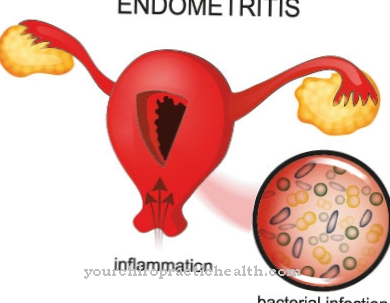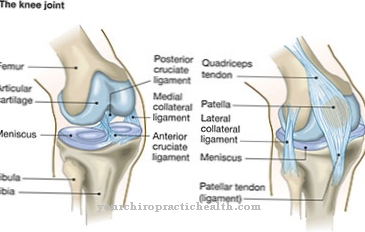A necrotizing fasciitis is a bacterial infection of the skin, subcutaneous tissue and muscles. The most common pathogens are group A streptococci, staphylococci or clostridia. The affected tissue must be completely removed so as not to endanger the life of the patient.
What is necrotizing fasciitis?

© designua - stock.adobe.com
Fasciitis is a necrotizing fascia disease. It is an inflammation in the fascial tissue that causes cells to perish. The inflammatory disease is also called necrotizing fasciitis designated. The incidence is given as up to one case per 100,000 inhabitants. The inflammation is bacterial and shows rapid progression.
Affected are the skin and subcutaneous tissue with involvement of the fascia. For this reason, the disease is classified as a bacterial soft tissue infection. The most important risk factors include circulatory disorders as they can occur in the context of higher-level metabolic diseases. Depending on the species of bacterial pathogen, two subgroups of nacrotizing fasciitis are distinguished.
These subgroups are referred to as type I and type II of the disease and can show different courses. Infections are generally more severe in immunodeficient patients. If the bacteria involved reach the bloodstream of these patients, the risk of sepsis or septic shock is high. As a consequence, necrotizing fasciitis can develop into a life-threatening condition for immunodeficient patients.
causes
People with circulatory disorders in peripheral vessels are most often affected by necrotizing fasciitis. Disorders of the lymphatic drainage and immunodeficiency also promote the development of the disease. Metabolic disorders, especially diabetics, are particularly at risk. The infection is usually triggered by lesions or abscesses on the skin that allow bacteria to enter the subcutaneous tissue.
Intramuscular injections such as therapeutic injections for diabetes or therapeutic surgical interventions can also open the gates to the subcutaneous tissue for bacteria. Group A streptococci are considered to be the most important pathogen causing necrotizing fasciitis. Staphylococci or clostridia can also theoretically cause the infection, but are rarely involved in clinical practice.
Sometimes the infection is also a mixed infection:
- Type 1 necrotizing fasciitis, for example, corresponds to an aerobic-anaerobic mixed infection and occurs primarily after surgical interventions. * Type 2 necrotizing fasciitis is caused by group A streptococci, making it the most common form of infection.
- A special form of necrotizing fasciitis is Fournier's gangrene in the groin and genital region, which particularly affects men. Newborns with omphalitis are more susceptible to necrotizing fasciitis of the umbilical area.
Symptoms, ailments & signs
Patients with necrotizing fasciitis suffer from unspecific symptoms at the beginning of the infection. The initial symptoms mainly include local pain and more or less high fever. These complaints are initially often associated with chills, fatigue and similar signs of infection.
Within the first week, the areas slowly swell due to inflammatory processes. Usually the skin over the infectious focus is bluish-red in color and becomes bluish-gray as it progresses. Due to the inflammatory processes in the subcutaneous tissue, the upper one overheats and often throws confluent bubbles. The bubbles contain a light to dark red liquid with a viscous consistency.
At an advanced stage, the affected tissue becomes necrotic. The necroses can be more or less extensive and usually not only affect the soft tissue, but also the nerves and muscles. From this point on, pain is usually no longer present, as the sensitive nerves in the area die off piece by piece.
In most cases, the patient's fever rises during these processes. When the pathogens involved reach the bloodstream, a temporary bacteremia occurs in immunologically healthy patients, which is balanced out by the immune system. In immunocompromised patients, the bacteremia can persist and lead to sepsis.
Diagnosis & course of disease
Air inclusions in the muscle fascia can be documented using CT when diagnosing necrotizing fasciitis. If there is a suspicion, a microbiological diagnosis is carried out in which the blisters are punctured or biopsies are performed. A gram preparation provides crucial diagnostic information. The microbial culture is one of the standard diagnostics.
An early diagnosis has a positive effect on the prognosis. Because of the rapid progression, mortality with delayed diagnosis is high, especially for type II, at 20 to 50 percent. The prognosis is unfavorable, especially if the trunk area is involved.
Complications
In this disease, people suffer from a bacterial infection. In most cases, however, the entire infected tissue is surgically removed, so that complications can usually be avoided. Patients with this disease suffer from a high fever and also from tiredness and fatigue.
Pain in the limbs and headaches can also occur and significantly reduce the patient's quality of life. There is also swelling on the skin and the skin itself usually turns brown. Furthermore, blisters will form on the skin. If the disease is not treated, the nerves die and paralysis or other disorders of sensitivity occur. This nerve damage is usually irreversible and cannot be restored.
In serious cases, illness can also result in blood poisoning and thus death of the person concerned. Usually the disease is treated without complications. With the help of antibiotics, most complaints can be limited relatively well. With an early diagnosis, there is a completely positive course of the disease and not a decrease in the patient's life expectancy.
When should you go to the doctor?
Symptoms such as chills, fever and fatigue always require a doctor's examination. If skin changes are added to these complaints, the underlying cause may be necrotizing fasciitis, which must be diagnosed and treated immediately. The risk groups include people who suffer from circulatory disorders, immunodeficiency or disorders of lymphatic drainage. Diabetics and patients with abscesses, skin injuries or bacterial infections are also at risk and should have the described symptoms cleared up quickly.
If the symptoms arise in connection with therapeutic injections, the responsible doctor must be informed. A doctor must be consulted at the latest when visible necrosis and the associated pain in the limbs or signs of blood poisoning appear. Those affected can see their family doctor or a dermatologist. Depending on the type and severity of the necrotizing fasciitis, other specialists will then be involved in the treatment. An advanced disease must be treated as an inpatient, with the necrosis removed surgically. Due to the high risk of infection, any surgical wounds must also be monitored and treated by a specialist.
Treatment & Therapy
Necrotizing fasciitis is treated surgically. All affected soft tissues must be radically removed as soon as possible. If too little tissue is removed, the fasciitis spreads at high speed and leads to high tissue loss or even death. The pathogens of the infection are extremely aggressive pathogens, so that no germs should be left in the tissue during the operation.
The surgical intervention is usually combined with drug therapy. This therapy consists of three times daily administration of clindamycin, which is often administered in combination with penicillin. Many of the pathogens are resistant to antibiotics. Therefore, a purely antibiotic treatment is usually not effective. When all surgical and medical measures have been exhausted and no improvement has been achieved, the affected limbs must be amputated to save the patient's life.
You can find your medication here
➔ Medicines against redness and eczemaOutlook & forecast
Immediate surgical therapy significantly improves the patient's prognosis. Factors such as the old age of those affected, the female gender, and concomitant diseases such as diabetes mellitus also influence the prognosis. It has also been proven that necrotizing fasciitis of the body trunk is associated with a significantly worse outlook for those affected. Likewise, a significantly increased amputation rate and mortality rate can be mentioned for necrotizing fasciitis, especially after injection therapy. Therefore, knowledge of all these different prognostic factors should be the basis for the doctor's quick decision at the time of inpatient admission.
After surgical therapy, intensive medical complex therapy and the administration of antibiotics are the main focus for those affected. Surgery may cause patients to need large amounts of intravenous fluids. Therapy in a high pressure oxygen chamber is also recommended afterwards. However, it has not been established to what extent this is helpful.
If toxic shock syndrome develops in the course of the disease, immunoglobulin is given. The general death rate averages 30%. The prognosis is poorer in elderly patients, accompanied by other medical disorders and in an advanced stage of the disease. Delay in diagnosis and treatment, and insufficient removal of dead tissue, worsen a prognosis.
prevention
Since poor blood circulation and immunodeficiency are considered risk factors for necrotizing fasciitis, measures to strengthen the immune system and promote blood circulation can be interpreted as preventive measures in the broadest sense.
Aftercare
After the surgical removal of a necrotizing fasciitis, an intensive follow-up inspection of the tissue is very important.Regularly taken tissue samples are used to examine whether bacteria can still be detected. The affected patients are also prescribed antibiotics.
One problem, however, is that many bacteria that cause necrotizing fasciitis are resistant to conventional antibiotics. There is a risk that new wounds will form and enlarge rapidly. For this reason, various preparations are administered in the first few days after the operation and tests are carried out to determine whether any possible bacteria are attacked.
When a suitable antibiotic has been found, patients are dependent on taking the preparation for several weeks. This is the only way to reduce the risk that the necrotizing fasciitis will recur. If organs or limbs have already been attacked by the disease, further operations and therapies may have to be carried out in order to treat the long-term effects of the disease.
Patients with diabetes mellitus are a risk group. Since diabetes significantly increases the incidence of wounds, patients with diabetes mellitus need intensive care. A regular examination, for example by a diabetologist, should ensure that even small wounds do not form. This is to prevent bacteria from nestling in the tissue and triggering necrotizing fasciitis.
You can do that yourself
Necrotizing fasciitis is life-threatening, and under no circumstances should those affected try to treat the disorder themselves. But that does not mean that patients cannot help reduce the risk and mitigate the consequences of the course of the disease. The sooner the fasciitis is recognized as such, the higher the chances that an amputation can be avoided.
Members of risk groups, including in particular diabetics and people with an immunodeficiency, should therefore also closely monitor small everyday injuries and identify the symptoms of fasciitis. Anyone who suffers from diabetes and suddenly develops a fever shortly after a minor injury while peeling potatoes should not dismiss it as the beginning of a cold, but instead consult a doctor as a precaution. Risk patients should also reduce their risk of injury. Small cuts or abrasions cannot always be avoided. However, the probability of occurrence can be reduced. In particular, protective gloves should always be worn when gardening and doing manual work.
If an injury occurs anyway, the wound must be cleaned and disinfected immediately. Optimal initial care for the wound can reduce the risk of infection and thus fasciitis. Diabetics can also help strengthen their immune system and improve blood flow to the limbs through a healthy diet and regular exercise. This also reduces the risk of fasciitis.


.jpg)


.jpg)


















.jpg)



